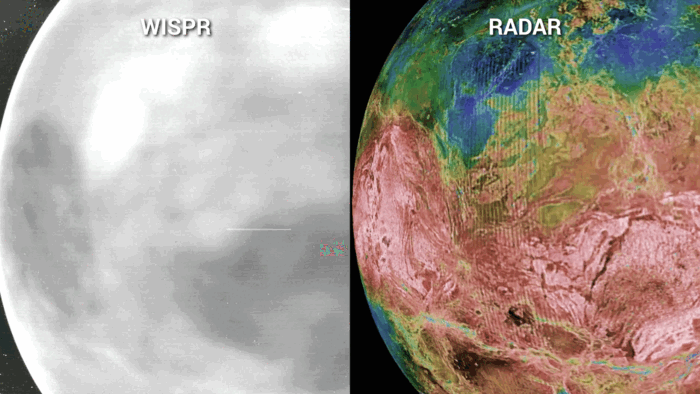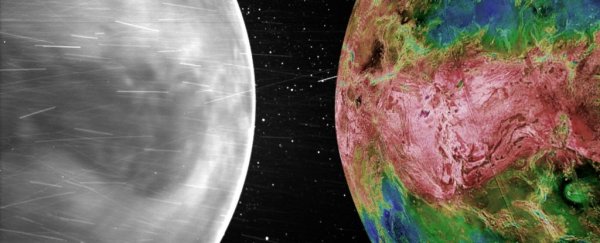New images recorded by NASA's Parker Solar Probe have revealed the red-hot glow of Venus's surface radiating through its shroud of toxic clouds – a finding that could help us better understand the minerals making up this rocky and mysterious planet.
Using data from the Wide-field Imager for Parker Solar Probe (WISPR) instrument, scientists were able to peer beneath the planet's thick atmosphere, discovering geological features such as highlands, plateaus, and plains.
"Venus is the third brightest thing in the sky, but until recently we have not had much information on what the surface looked like because our view of it is blocked by a thick atmosphere," says astrophysicist and WISPR team member Brian Wood of the US Naval Research Laboratory.
"Now, we finally are seeing the surface in visible wavelengths for the first time from space."
Although relatively close to Earth, Venus has proven very difficult to study. It's known as Earth's "evil twin", because, while similar to Earth in size, mass, structure, and composition, it's deeply hostile to life.
Earth is temperate and wet; Venus is dry and possibly volcanic, with surface temperatures averaging 471 degrees Celsius (880 degrees Fahrenheit).
Venus's sky is filled with thick, toxic clouds that rain sulfuric acid. These features make the planet difficult to investigate up close. Landers have been sent; they kind of end up melting. And those suffocating clouds make external observations of the surface, not impossible, but tricky.
This is where WISPR ended up surprising scientists. Last year, it took some images of Venus's night side that seemed to show surface features through the cloud layers.
"The images and video just blew me away," Wood says.

WISPR is optimized for visible light; that is, it takes images in wavelengths that the human eye can see. But it turned out that the instrument can also see a little bit further, into the near-infrared part of the spectrum invisible to human eyes. Infrared and near-infrared are the wavelengths of thermal energy; in other words, heat.
On Venus' day side, warmed by the Sun, any infrared emissions from the surface would be lost. But on the night side, it seems temperature variations on the planet's surface are unexpectedly detectable by the instrument.
"It's so hot that the rocky surface of Venus is visibly glowing, like a piece of iron pulled from a forge," Wood explains.
Other technologies, such as radar imaging conducted by the Magellan probe in the 1990s, and infrared imaging conducted by the current JAXA Akatsuki probe, have given us a pretty good map of Venus' surface geology. WISPR's contribution, the researchers say, brings our understanding right to the very edge of the visible spectrum.
The flyby last year revealed a region called the Aphrodite Terra, the largest highland region on the surface of the planet. It showed up as a dark smudge against the luminous clouds. This is because the Aphrodite Terra, with its higher altitude, is a lot cooler than the surrounding terrain, so in infrared or near-infrared images of the planet, it's visible.
 WISPR and Magellan data, side by side. (NASA/APL/NRL/Magellan Team/JPL/USGS)
WISPR and Magellan data, side by side. (NASA/APL/NRL/Magellan Team/JPL/USGS)
Those images show other features, too. The Tellus Regio plateau and the Aino Planitia plains also feature variations in altitude that make them visible through the clouds in infrared wavelengths.
Although the images haven't revealed anything new in terms of topography, the data can still help us better understand Venus. Because different minerals conduct and release heat differently, the emissions can be used to try to reconstruct the planet's surface mineralogy.
This, in turn, can help us understand its history. We know, for example, that Venus has been highly volcanically active in the past.
Studying its surface can help us understand how widespread, and how recent, that activity was. Adding visible and near-infrared data to the currently available dataset expands the range of wavelengths scientists can use to do this.
Parker's primary objective is to explore the Sun; its Venus observations are almost incidental. The probe is using the planet to make gravity assist maneuvers, using Venus's gravity to make velocity and course adjustments on its solar mission.
It's scheduled to make seven of these maneuvers in total; so far it has made five. Only two of those have been suitable for these night-side images so far.
Of the two remaining gravity assists, only one will allow for more observations: the final gravity assist, scheduled for 6 November 2024. We'll be fascinated to see what else WISPR might find.
"We're thrilled with the science insights Parker Solar Probe has provided thus far," says physicist Nicola Fox of NASA's Heliophysics Division.
"Parker continues to outperform our expectations, and we are excited that these novel observations taken during our gravity assist maneuver can help advance Venus research in unexpected ways."
The research has been published in Geophysical Research Letters.
